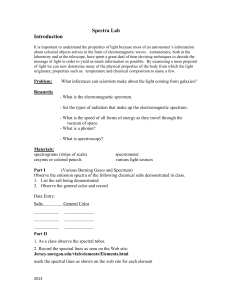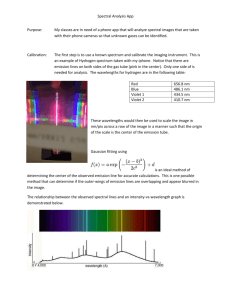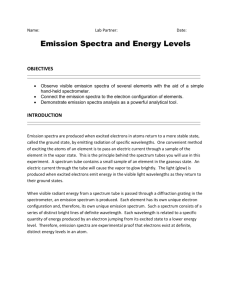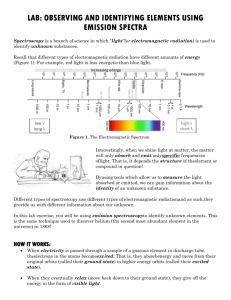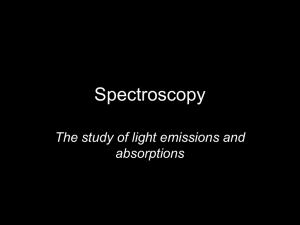Light & Spectra Lab - Micds
advertisement
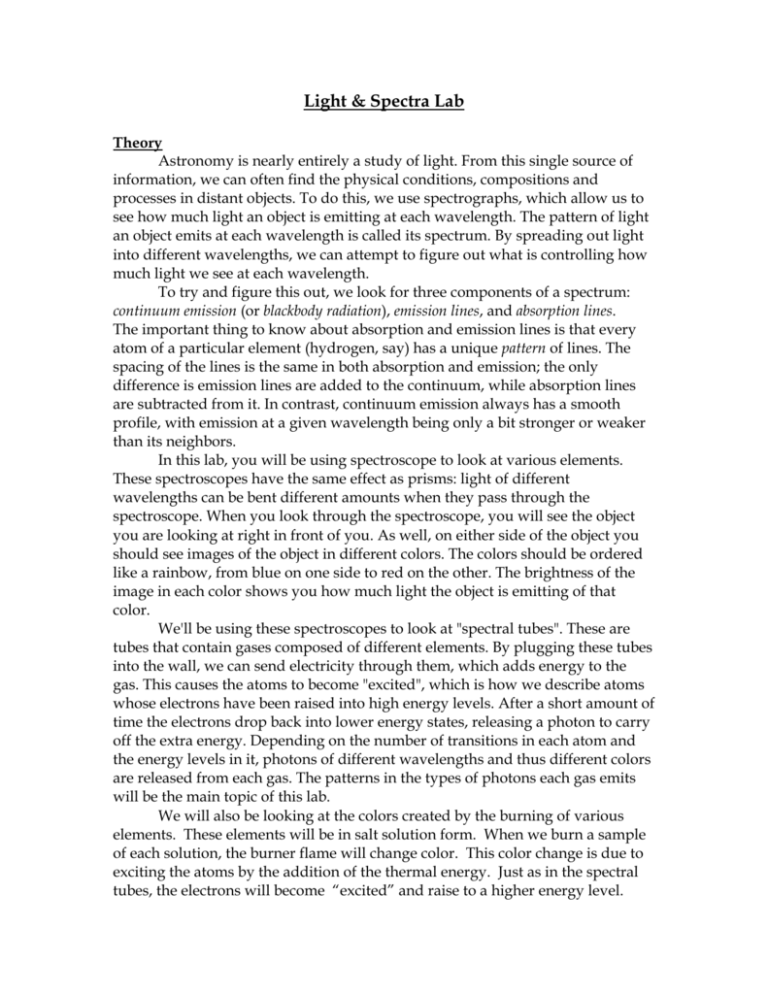
Light & Spectra Lab Theory Astronomy is nearly entirely a study of light. From this single source of information, we can often find the physical conditions, compositions and processes in distant objects. To do this, we use spectrographs, which allow us to see how much light an object is emitting at each wavelength. The pattern of light an object emits at each wavelength is called its spectrum. By spreading out light into different wavelengths, we can attempt to figure out what is controlling how much light we see at each wavelength. To try and figure this out, we look for three components of a spectrum: continuum emission (or blackbody radiation), emission lines, and absorption lines. The important thing to know about absorption and emission lines is that every atom of a particular element (hydrogen, say) has a unique pattern of lines. The spacing of the lines is the same in both absorption and emission; the only difference is emission lines are added to the continuum, while absorption lines are subtracted from it. In contrast, continuum emission always has a smooth profile, with emission at a given wavelength being only a bit stronger or weaker than its neighbors. In this lab, you will be using spectroscope to look at various elements. These spectroscopes have the same effect as prisms: light of different wavelengths can be bent different amounts when they pass through the spectroscope. When you look through the spectroscope, you will see the object you are looking at right in front of you. As well, on either side of the object you should see images of the object in different colors. The colors should be ordered like a rainbow, from blue on one side to red on the other. The brightness of the image in each color shows you how much light the object is emitting of that color. We'll be using these spectroscopes to look at "spectral tubes". These are tubes that contain gases composed of different elements. By plugging these tubes into the wall, we can send electricity through them, which adds energy to the gas. This causes the atoms to become "excited", which is how we describe atoms whose electrons have been raised into high energy levels. After a short amount of time the electrons drop back into lower energy states, releasing a photon to carry off the extra energy. Depending on the number of transitions in each atom and the energy levels in it, photons of different wavelengths and thus different colors are released from each gas. The patterns in the types of photons each gas emits will be the main topic of this lab. We will also be looking at the colors created by the burning of various elements. These elements will be in salt solution form. When we burn a sample of each solution, the burner flame will change color. This color change is due to exciting the atoms by the addition of the thermal energy. Just as in the spectral tubes, the electrons will become “excited” and raise to a higher energy level. Then, after a short period of time, the electrons will fall back to its lower energy level. When this occurs, a photon will carry off the extra energy and we see the color change. Objectives Students examine emission from spectral tubes and a continuum source through diffraction gratings or glasses and use their experience with the spectral tubes to visualize the different energy levels of atoms. Students will also examine the color change of burner flames due to the burning of various elements in solution. Procedure Pre-Laboratory Exercise Using a compact disc, observe the emission of the following sources of light: Filament Light bulb Sun Street Lamp Flash Light Bic® Lighter Record your observations in your laboratory notebook. Part I - Spectral Tubes 1. Once you have received a spectroscope and become comfortable with how to use it, the teacher will darken the room and turn on a number of "spectral tubes" located at various points around the room, as well as identifying a source of continuum radiation for you to examine. 2. Look at all the spectral tubes, as well as the continuum source, and draw a bright-line spectrum for each source. Be certain to label each spectrum that you create. Things to think about as you draw your spectrums from each source: Are the lines closely packed, or spread out over many different colors? Are there many lines you can see, or only a few? How do the colors of the lines from each tube relate to the color you see from each tube when you don't look through the gratings? 3. Locate the unknown spectral tubes. Draw a bright-line spectrum for each. Part II - Flame Test 1. Dip the tip of the wire into the salt solution. Place the tip of the wire into the center of the Bunsen burner. Observe the color emitted. Repeat for all available salts solutions. 2. Locate the unknown salt solutions. Dip the tip of the wire into the unknown salt solution. Record your observations. **Pre-Lab: Go to WebAssign and complete assignment Data/Observations Pre-Laboratory Exercise—write down general observations in your lab notebook Part I—create a bright-line spectrum for each element in your lab notebook as demonstrated below: RED ORANGE YELLOW GREEN BLUE INDIGO VIOLET Part II—write down general observations in your lab notebook Questions from Part I 1. What is the difference between the spectrum you see from the spectral tubes and the spectrum you see from the continuum source? What causes the two spectra to look so different? Describe the physical processes that lead to the creation of continuum or emission line spectra. 2. The patterns we've seen in emission spectra in this lab and in the absorption spectra drawn below are controlled by the spacings of energy levels in atoms. Since photons are absorbed and emitted when electrons move between these energy levels, the spacing between those levels determines the kinds of photons that element can emit. Answer the questions below about an atom with energy levels like those shown to the right. (note: we've labeled each level with a number n, which gets bigger as the energy of the level gets larger.) Draw arrows on the diagram to the right showing all the transitions an electron could make which would result in the emission of a photon. How many emission lines could we observe from this atom? __________ Which transition would emit light with the highest frequency (shortest wavelength)? From n = _______ to n = ________ . Which transition would emit light with the lowest frequency (longest wavelength)? From n = _______ to n = ________ . 3. Examine the following spectra: Solar Spectrum from Sun (Emission spectrum) Laboratory Spectum of Iron (Absorption spectrum) What is the evidence for the claim that iron exists in a relatively cool outer layer of the Sun? 4. Spectral lines are sometimes referred to as "atomic fingerprints". What is it about each element that causes them to have unique spectra? 5. Promotional signs are often made by bending colorfully glowing tubes into words or pictures. We usually call these "neon signs". However, you've seen in this lab that a tube with pure neon emits a very distinctive spectrum, and appears orange to the eye. How do you think a sign with colors other than orange in it is made? 6. Consider the energy level diagram that let you predict which energies (lines) existed for hydrogen. Which energy level transitions did you see? Which energy level transitions did you feel? Which energy level transitions would do damage to your skin if your sat in front of the hydrogen tube long enough? 7. Identify the unknown spectra tubes. Be certain to provide the reasoning for your decision. Questions from Part II 1. List all the ions that were tested from the Alkali metals. 2. Now list them with their emitted colors from lowest energy to highest energy. 3. How does this compare to their positions on the Periodic Table? 4. Repeat steps 1-3 for the Alkaline Earth metals. 5. Explain the relationship between the energies of light emitted and the positions of the elements on the periodic table. In your answer refer to the principle quantum number of the very outermost electrons (valence electrons) of the elements. 6. Paper logs soaked in solutions of metal salts and dried are sold for fireplaces. Which ions would give the best colors that would be most visible for your added enjoyment? 7. Identify the unknown elements. Be certain to provide the reasoning for your decision. Sources Adapted from the Astronomy Department at the University of Washington



